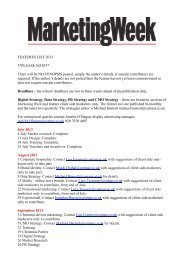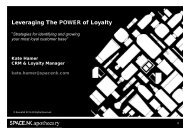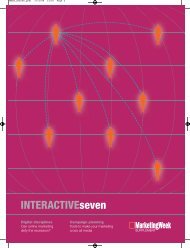Effectiveness 08 - Marketing Week
Effectiveness 08 - Marketing Week
Effectiveness 08 - Marketing Week
Create successful ePaper yourself
Turn your PDF publications into a flip-book with our unique Google optimized e-Paper software.
MW_0910<strong>08</strong>_p090 6/10/<strong>08</strong> 2:50 pm Page 90ith the emergence of somany different mediachannels, it’s easy formessag es to become lost among themarketing hierarchies, especiallywhen so many people are involved inmanaging the brand.When I worked for Orange in1999, the agency hierarchy was clear:WCRS and Wolff Olins. WCRS didthe advertising and Wolff Olins tookcare of the brand. Other agencies satunderneath them, with commun -ications agencies taking directionfrom WCRS.What Orange did then was to get allthe different advertising elementslooking the same across all itschannels. TV looked the same as print,and both of them looked the same asthe posters and direct mail.When I went to mobile operator O2in 2003, the hierarchy was different.There was still an agency at the top ofthe tree – VCCP – but it wasn’t actinglike an ad agency. Advertising nolonger had the best spot at the toptable. In this case, VCCP had some ofthe best people, but they were the bestbecause of the clever ideas they had,rather than because they worked foran advertising agency.Between 2003 and now, marketershave been travelling along the samegeneral trajectory as the examples I’vegiven, trying to get their ideas into asmany media channels as possible.Unfortunately, those channels have nowmultiplied dramatically. There used tobe just TV, digital, and above- andbelow-the-line. Now the digital channelencompasses many things, includingmobile, email, social media andbroadcast sites such as YouTube.Even though there are all thesechannels, people are trying to do thesame thing as always: take a campaign,amplify its effects and activate it in allthe different areas.Instead of following the old hier arc -hical models in this new environment,we are trying to do something differentat Nokia. We no longer have advertisingat the top of the tree. We don’t have avery clear pyramid dictating who doeswhat – it’s much more a collective ofagencies, all of whom are equal andthe best idea wins.What that means is you can’t takea single campaign and put it into asmany different channels as possible.You’d have chaos because you cannotchase consumers down all their dif -ferent digital and non-digital avenues.As a consumer, you are probablyexposed to more than 1,000 differentmedia sources. These used to be prettysimple things, like posters and parkingtickets. But now they are increasinglyobscure and diverse. The multitude ofblogs alone means it has becomeimpossible to get ideas out there in acomplete – or 360˚ – fashion.This climate also makes thingsdifficult from an agency’s point of view.It’s tricky to manage any mediaappearing within the differentplatforms because you can never followthe consumer down every one of thosediverse channels.You also can’t spend your moneyproperly. If you were to try to createa genuinely 360˚ campaign, you couldpotentially spend many millions ofpounds because it wouldn’t be clearwhere to stop. The budget would befrittered away across all the differentareas, trying to create that elusive360˚ reach.With more channels than everalongside new agency structures andmodels, brands and their marketersneed to accept that 360˚ marketingis going to become increasinglydifficult to do. I think that marketingdirectors will stop doing so much360˚ planning and spending. Instead,they will start concentrating theirbudgets on smaller areas, withgreater effect.Companies should work on a reallycreative TV slot or a truly engagingdigital campaign, rather thansomething more general. This is wherethe future of marketing is going – youare going to have to do less, but better. ●OCTOBER <strong>08</strong> STRATEGIC THINKING FOR TODAY’S MARKETING PROFESSIONALISSUE34n a house in a little French village,a man lies dying. His son is askedto procure him his last request: aglass of Stella Artois. After whatseems an incredible journey throughthe countryside, the son finds the beer,only to give in to temptation and drinkit before reaching his father. He thenblames the betrayal on the priest performingthe last rites.This cinematic story – referencingclassic film Jean de Florette – is thebasis of one of Stella Artois’ mostfamous adverts. Andreas Hilger, marketingdirector at the brand’s owner,InBev UK, explains: “TheBelgian heritage andcraftsmanship ofStella Artois hasbeen stressed fromthe beginningacross all the marketsthe brandoperates in.”The beer’sadvertisingcampaigns,created by outgoingagency Lowefor the past 26years, have triedto associate thedrink with Europeanculture andgood taste. But therehas increasinglyappeared a credibilitygap between the brand’smarketing and the realityof its consumption.In markets such as the UK,where the brand’s strapline boasts thatit is ‘reassuringly expensive’, thedrink’s popularity and trade discountinghas made it widely available. As aresult, it has gained the nickname‘wifebeater’ among consumers becauseit is perceived as being drunk by abeer-loving, undesirable type of man.The brand’s image has become avictim of its own success.Tim Lindsay, president of adagency TBWA\ in the UK and Ireland,worked on the Stella Artois brand inthe 1980s while he was managingdirector at Lowe.He comments: “Stella built itsname on the ‘reassuringly expensive’campaign. Unfortunately, it then discountedthe product heavily throughboth on- and off-trade, failing to deliveron the brand promise.“This has led to ubiquity and bybecoming a plentiful, cheap, stronglager, it unwittingly became ‘wifebeater’– the beer of choice for angry menin white vests.”Now InBev is hoping to move awayfrom these negative associations. Thedrinks firm, in the process of buyingAmerican rival Anheuser-Busch,posted profits up 8.6% to €542m(£429m) in its second quarter this year,after a surprise 11% slump in the firstquarter due to rising raw materialprices. But Stella Artois volumes weredown 5.1% in Western Europe in thesecond quarter, with sales sliding in itsdominant British market.The company is banking on a newmarketing strategy that highlightsStella Artois’ natural ingredients andSPONSOR BRAND STRATEGYBrand Strategy is the leading monthly international marketing title forsenior executives. Each issue provides readers with the ideas, tools,case studies and research to help ensure that marketing is an effectiveand rigorous discipline.Ruth MortimerEditorSt Giles House50 Poland StreetLondonW1F 7AXT 020 7970 4000E ruth.mortimer@centaur.co.ukW www.brandstrategy.co.ukAdvertising Sales Please contactLiz Pavitt on 020 7970 6413Disciplines <strong>Marketing</strong> and businessjournalismEstablished 1996Recent case studies in Brand Strategy go behind the scenes at brandssuch as Orange, Stella Artois and Pepsi to ask what has made thesebrands successful. We look at the ideas, initiatives and insights theyare using to stay ahead of the competition and tackle any challengesin their businesses.Our recent profilees include the chief executive of Ryanair, MichaelO’Leary, the fashion designer and brand owner Orla Kiely and HP’schief marketing officer Michael Mendenhall. We examine how thesepersonalities have shaped their companies so our readers can learnfrom their experiences.You can find more than ideas in Brand Strategy, however. Our regularresearch section includes exclusive data from TNS and YouGov. Wealso run league tables of global brands with exclusive analysis fromBrand Finance because it is vital to see the impact of marketing on thebottom line.We are involved with the <strong>Marketing</strong> <strong>Week</strong> <strong>Effectiveness</strong> Awardsbecause we believe that, ultimately, a brand strategy should be abusiness strategy.Will Harris<strong>Marketing</strong> directorNokia UKOne size no longer fits allWill Harris explains why thedays of ‘360˚ marketing’campaigns are overW‘‘Collective approachIf you were to try to create a genuinely360˚ campaign, you could potentiallyspend many millions of poundsbecause it wouldn’t be clear where tostop. The budget would be fritteredaway across all the different areas,trying to create that elusive 360˚ reachSpecialised campaignsOctober 20<strong>08</strong> Issue 226DESIGN Orla Kiely on how her retro style has led to a £100m future 20CULTURE Can InBev turn around Artois and achieve a Stella performance? 34BUSINESS Exclusive analysis of the top global telecoms brands 52How today’sGeneration YChineseare decidingwhat brandsthe world willbuy tomorrowwww.brandstrategy.co.uk Forward thinking, forward moving, find the future226Catch a falling starIStella Artois’ cultured,concerns. How can it“Stella built its name on the ‘reassuringly expensive’campaign. Unfortunately, it then discounted the productheavily, failing to deliver on the brand promise”90 The 10th Annual <strong>Marketing</strong> <strong>Week</strong> <strong>Effectiveness</strong> Awards








